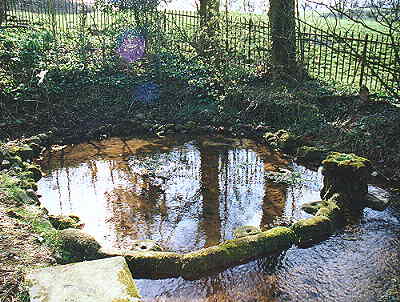|
 St
Helen's Well - Eshton St
Helen's Well - Eshton
(SE 9310 5700)
St Helen's well is located in a small enclosure alongside the road from
Gargrave to Winterburn. A low stone wall surrounds part of the well pool
and several strong springs can be seen
bubbling up through the silt at the bottom. These springs supply a large
quantity of water, which flows out past the enclosure wall and away to
join the nearby Eshton
Beck.
The stones forming the enclosure wall are thought to have come from
Gargrave Church, and these include three rounded stone blocks which are said to be carved heads with
their faces submerged below the water line. The holes in the top of the
blocks suggest they might also have supported railings similar to those
around the enclosure.
The symbolism of the stone heads, three in number, with faces below the
surface 'guarding' the source of the water, provides an archaic image
straight out of Celtic mythology. However the church stones are likely to
have been a relatively recent addition to the well.
R.C. Hope (1), writing in 1893, reports that .....
"It was customary for the younger folk to assemble and drink the
water of this well mixed with sugar on Sunday evenings. The ceremony
appears now to have died out. It was in vogue late in the last
century."
Elsewhere in his book, Hope also mentions a St Helen's well at Gargrave,
which is likely to be this same well, as Gargrave is less than two miles
away. "The water of this well was a certain cure for sore and
weak eyes. Whitaker states that in his time votive offerings, such as
ribbons and other decorative articles were commonly to be seen tied to
the bushes near these wells."
On a visit to the well in Feb 1999 there were several strips of cloth tied
to branches near the well and the site appeared to be visited regularly
and looked after.
Regrettably in early 2004 the walling across the pool was pulled apart
by thieves who stole the 'head' stones. Such vandalism and theft is
truly shameful and it is to be wondered who would go to such lengths.
Leaving aside the possibility of some misguided followers of the
old or new religions, it seems most likely the stones were stolen
by the dubious characters who trade in antique stonework, selling them
on at inflated prices as garden 'features'. Theft of stone troughs,
statues and other carved stonework has apparently increased alarmingly
in recent years and it can only be to supply this trade, so it's worth
considering where those 'reclamation' yards get their stock.
The numerous strips of cloth and knotted threads hung on the branches
around this holy well indicate that it is still regarded as a potent
site, and it certainly has a noticeable 'atmosphere' in the late
evening. So lets hope the thieves and desecrators
get what they deserve!
(1) R.C. Hope, - The Legendary Lore of the
Holy Wells of England, 1893.
|